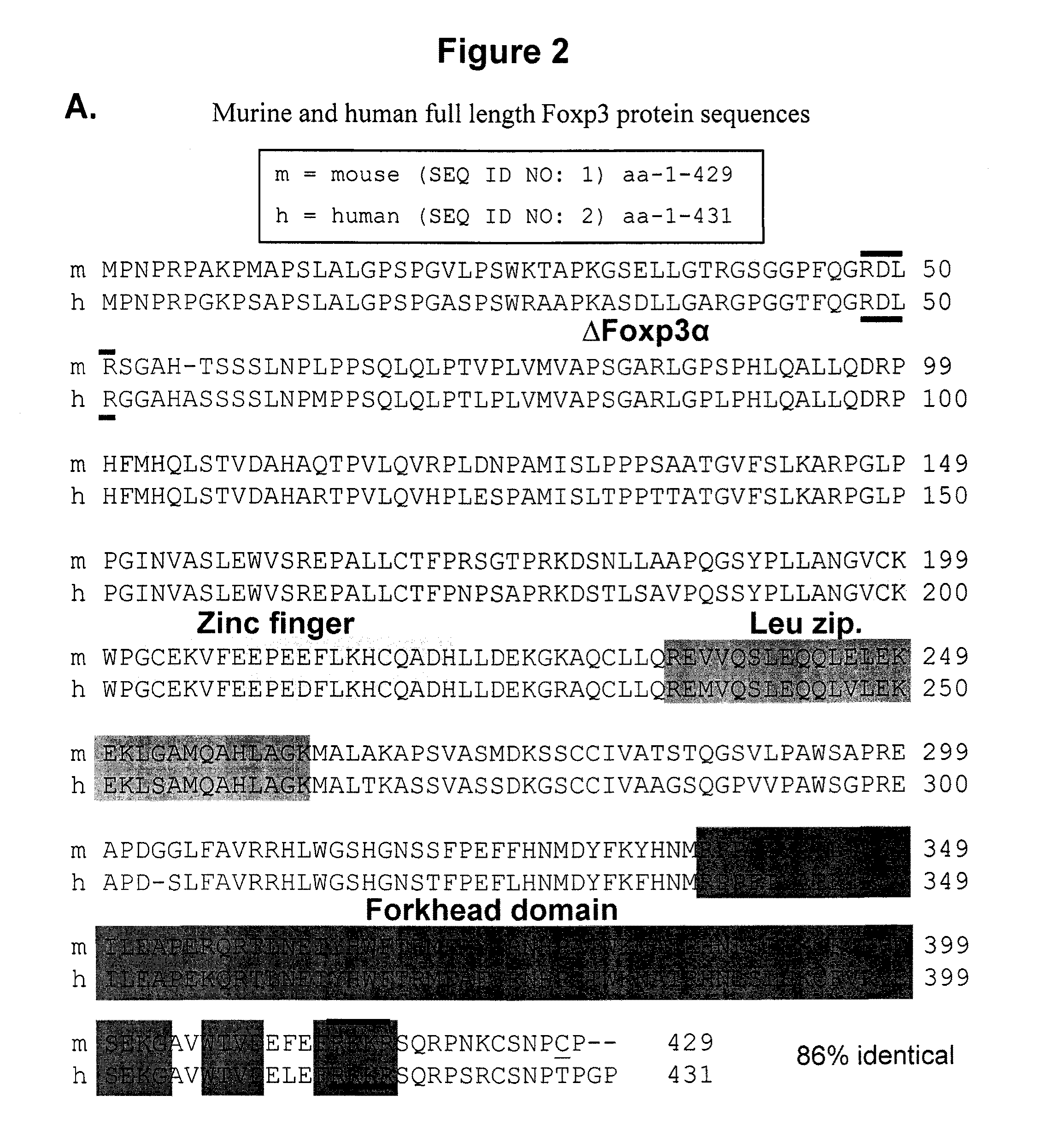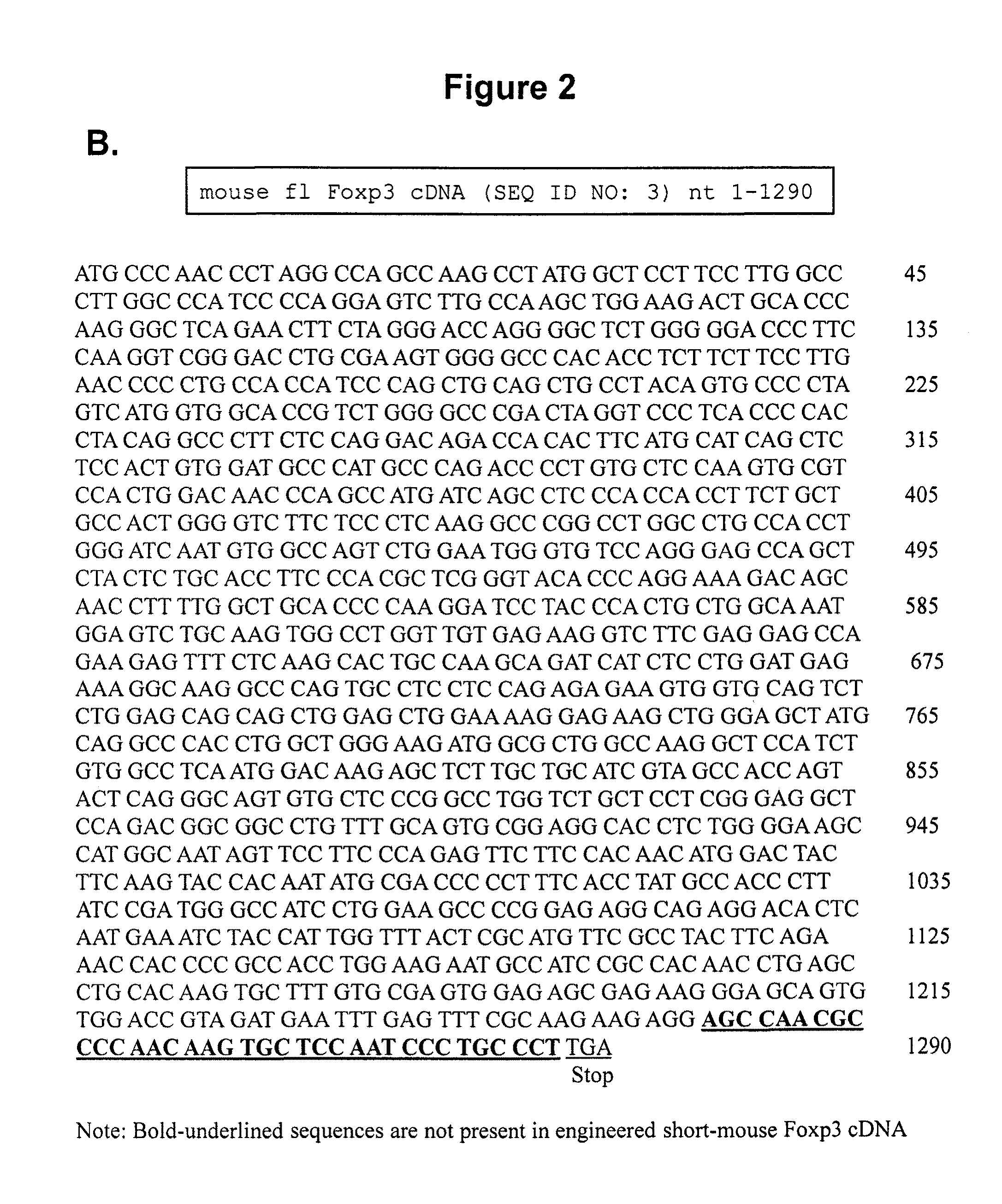Compositions and Methods for Regulating T-Cell Activity
a technology of t-cell activity and composition, applied in the field of molecular biology and immunology, can solve the problems of poor clinical prognosis, correlated treg infiltration (and foxp3 expression) into tumors, and most male patients are severely affected and die, and achieve the effect of modulating treg function and activity, reducing the risk of t-cell death, and increasing the formation of a peptide selected
- Summary
- Abstract
- Description
- Claims
- Application Information
AI Technical Summary
Benefits of technology
Problems solved by technology
Method used
Image
Examples
example i
[0131]Foxp3 Gets Cleaved at the RKKR↓S (SEQ ID NO: 188) Site to Yield a Shorter Protein Product that is Functional
[0132]The removal of the C-terminal 12 amino acids immediately following the RKKR (SEQ ID NO: 179) renders Foxp3 functional, indicating a block of function mediated by the neighboring C-terminal domain. Since these basic residues are involved in DNA binding (29), certain structural changes in the C-terminal domain should be taking place allowing interaction with DNA. This can be accomplished either through complex formation in which factors that complex with Foxp3 displace the C-terminal domain and expose the RKKR (SEQ ID NO: 179), or allowing interaction with DNA or simply by cleavage of Foxp3 immediately following the RKKR (SEQ ID NO: 179) sequence.
[0133]The first evidence that Foxp3 gets cleaved at the C-terminus was obtained using a C-terminal Flag-tagged Foxp3 construct. The flag-tagged Foxp3 was retrovirally expressed in cells and then the protein was detected by W...
example ii
Proteolytic Processing of Foxp3 Occurs at the Chromatin Level
[0145]Several attempts were made to resolve the cleaved and uncleaved forms of Foxp3 by SDS-PAGE, but the small size difference (12-aa) between the two forms proved challenging. To assist with resolution by SDS-PAGE, the C-terminal tail (sequences past RKKR (SEQ ID NO: 179)) was extended from 12-aa to 31-aa (FIG. 5A). Cytoplasmic and nuclear extracts from CD4+ T cells transduced with retroviruses encoding wild-type or extended Foxp3 were analyzed by Western blotting for cleaved and uncleaved forms. These extracts revealed only a single Foxp3 species that corresponded to the uncleaved (C-terminal-extended) Foxp3 (FIG. 5B, lanes 4 and 5).
[0146]Using material from these experiments, the chromatin-associated material that remained after nuclear extraction was analyzed. The protein:DNA ratio (by weight) in this fraction was approximately 2.8:1, a characteristic ratio for chromatin (74). Two major species of Foxp3 were detected,...
example iii
Generation of Short-Foxp3 Depends on an Intact RXXR (SEQ ID NO: 180) Motif
[0148]Since the C-terminal extensions allowed the cleaved and uncleaved forms of Foxp3 to be resolved by SDS-PAGE, the C-terminal extended construct was used as a template and further mutations were introduced into the RKKR (SEQ ID NO: 179) sequence to probe the role of the RXXR (SEQ ID NO: 180) motif (FIG. 8A). Constructs, each with 31-aa long tails (denoted with dashes, ---), were retrovirally expressed and cellular fractions analyzed by Western blotting. The short cleaved form of Foxp3 was again exclusively detected in the chromatin fraction (FIG. 8B, lane 3, marked with arrow) and could not be detected in the nuclear extract (FIG. 8B, lane 2), which contained uncleaved C-terminal extended and endogenous Foxp3 (FIG. 8B, lane 2, marked with asterisk). Expression of the mutant QNKR--- (SEQ ID NO: 181) showed the loss of the first arginine (R) results in much lower levels of the cleaved form (lane 4), and loss...
PUM
| Property | Measurement | Unit |
|---|---|---|
| nucleic acid | aaaaa | aaaaa |
| affinity | aaaaa | aaaaa |
| pathological self-reactivity | aaaaa | aaaaa |
Abstract
Description
Claims
Application Information
 Login to View More
Login to View More - R&D
- Intellectual Property
- Life Sciences
- Materials
- Tech Scout
- Unparalleled Data Quality
- Higher Quality Content
- 60% Fewer Hallucinations
Browse by: Latest US Patents, China's latest patents, Technical Efficacy Thesaurus, Application Domain, Technology Topic, Popular Technical Reports.
© 2025 PatSnap. All rights reserved.Legal|Privacy policy|Modern Slavery Act Transparency Statement|Sitemap|About US| Contact US: help@patsnap.com



